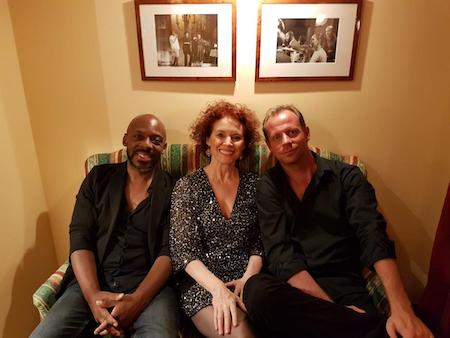Dec 9, 2025 12:28 PM
In Memoriam: Gordon Goodwin, 1954–2025
Gordon Goodwin, an award-winning saxophonist, pianist, bandleader, composer and arranger, died Dec. 8 in Los Angeles.…

“I know that tensions are high and emotions are intense right now, but the beauty of music is beyond words,” Arriale said.
(Photo: Sven Haefliger)Lynne Arriale honed her superb technical skills as a pianist and composer from rigorous training she received to become a classical pianist. But she first glimpsed her musical destiny at the age of 4, when she sat down at a toy piano and started to improvise.
“I remember playing ‘Moon River,’” Arriale recalled via Zoom from her home in Jacksonville, Florida, where she’s the professor of jazz studies and director of small ensembles at the University of North Florida. “I remember thinking with that melody, I could use different chords.” Bold for someone so young, but it would be years before she released her inner 4-year-old to become a nuanced and evocative artist.
“I didn’t really hear jazz until I was like 25,” said Arriale, who never heard of “’Round Midnight” until a teacher put the chart on her piano. “He told me to play the melody, and then create new melodies over the same chord changes. I said, ‘You’re kidding — I get to do that?’ And at that moment, I knew I had to learn to play jazz.”
Arriale was a quick study. Beginning with The Eyes Have It (DMP), her 1994 debut, she continued to create new melodies over the chord changes of her own multilayered compositions, as well as melodic reinventions of composers from Thelonious Monk to Tom Waits. She also built a prestigious career, releasing albums that made multiple best-of lists, including DownBeat’s Best CDs of 2020 for Chimes Of Freedom (Challenge). Chimes cemented her bond with drummer E.J. Strickland and bassist Jasper Somsen, who went on to produce the latest and most compelling album of Arriale’s career, The Light Is Always On (Challenge). The recording marks her 16th as a leader and her third release with this trio.
“March On,” the opener, sets the stage for a ripped-from-the-headlines suite of compositions that walk softly but carry a big stick. While her initial chords invoke a call to arms, the piece evolves toward the light that shines throughout an album inspired by an interview with Dr. Prakash Gada, a Tacoma, Washington, surgeon who worked through the darkest days of the pandemic.
“Dr. Gada said, ‘No one works from home,’” Arriale recalled. “‘The lights are always on.’ There were all these remarkable people who took care of us, day after day, in an almost warlike time, and that became the focal point of the album.” But Arriale took the concept a step further: “I extended it out to other people who stood up for their beliefs, even at their own peril. Heroes like Ruth Bader Ginsburg and John Lewis and Lieutenant Colonel Alexander Vindman reaffirmed how much goodness there is in the world, even during times that can make us feel a sense of despair.”
Amid the turmoil of the times, Arriale’s art imitated life in many ways. The steadfast chords of “Honor” salute Vindman, who stood up for Ukraine and bore witness against then-President Donald Trump during his first impeachment trial, foreshadowing Putin’s horrific invasion of Ukraine. “He’s everything a patriot should be, and he’s become an important voice in this horrible tragedy we’re witnessing,” Arriale noted. “The Notorious RBG” paid tribute to the legacy of Supreme Court Justice Ginsburg, but also presaged the inner strength of the latest Justice to join the bench, Kentanji Brown Jackson, who endured hostile Senate hearings before her appointment. “It was very inspiring to see her handle every question with such strength, grace and profound intelligence,” said Arriale.
Though she instinctually reaches for the light, Arriale heads “Into The Breach” of the Jan. 6, 2021, insurrection with uncharacteristic dissonance. “The heroes protecting the Capitol faced their own fellow citizens,” observed the composer, whose jarring chord collisions reflect the shocking events of that day. “I’m eternally grateful to them for defending our democracy.”
Arriale bridges that breach in the harmonious “Sounds Like America,” reflecting her belief that we’re all connected. “I know that tensions are high and emotions are intense right now, but the beauty of music is beyond words,” observed Arriale, whose lovely, meditative “Loved Ones” is a prayer for all those lost or separated during the pandemic. “When life brings us to our knees, somehow we get up again. There is always light. There’s always goodness. The human spirit is really unconquerable.” DB

Goodwin was one of the most acclaimed, successful and influential jazz musicians of his generation.
Dec 9, 2025 12:28 PM
Gordon Goodwin, an award-winning saxophonist, pianist, bandleader, composer and arranger, died Dec. 8 in Los Angeles.…

Belá Fleck during an interview with Fredrika Whitfield on CNN.
Jan 13, 2026 2:09 PM
The fallout from the renaming of the John F. Kennedy Center for the Performing Arts to include President Donald…

Flea has returned to his first instrument — the trumpet — and assembled a dream band of jazz musicians to record a new album.
Dec 2, 2025 2:01 AM
After a nearly five-decade career as one of his generation’s defining rock bassists, Flea has returned to his first…

Dec 11, 2025 11:00 AM
DownBeat presents a complete list of the 4-, 4½- and 5-star albums from 2025 in one convenient package. It’s a great…

“It’s a pleasure and an honor to interpret the music of Oscar Peterson in his native city,” said Jim Doxas in regard to celebrating the Canadian legend. “He traveled the world, but never forgot Montreal.”
Nov 18, 2025 12:16 PM
In the pantheon of jazz luminaries, few shine as brightly, or swing as hard, as Oscar Peterson. A century ago, a…